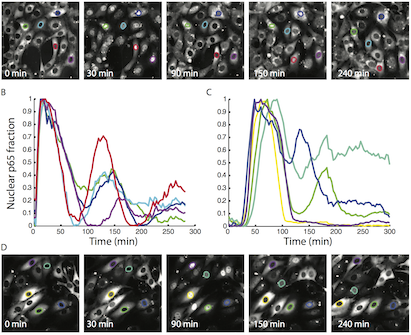Abstract
Nearly identical cells can exhibit substantially different responses to the same stimulus. We monitored the nuclear localization dynamics of nuclear factor kappaB (NF-κB) in single cells stimulated with tumor necrosis factor-α (TNF-α) and lipopolysaccharide (LPS). Cells stimulated with TNF-α have quantitative differences in NF-κB nuclear localization, whereas LPS-stimulated cells can be clustered into transient or persistent responders, representing two qualitatively different groups based on the NF-κB response. These distinct behaviors can be linked to a secondary paracrine signal secreted at low concentrations, such that not all cells undergo a second round of NF-κB activation. From our single-cell data, we built a computational model that captures cell variability, as well as population behaviors. Our findings show that mammalian cells can create “noisy” environments to produce diversified responses to stimuli.
Where applicable, full text and supplement provided for fair use.